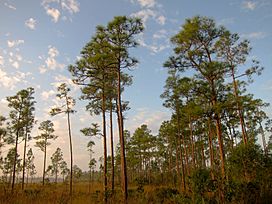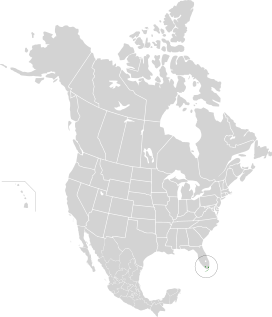South Florida rocklands facts for kids
Quick facts for kids South Florida rocklands |
|
|---|---|

Pine rockland in the Everglades
|
|
 |
|
| Ecology | |
| Realm | Neotropical |
| Biome | Tropical and subtropical moist broadleaf forests |
| Bird species | 176 |
| Mammal species | 36 |
| Geography | |
| Area | 2,100 km2 (810 sq mi) |
| Country | United States |
| State | Florida |
| Conservation | |
| Habitat loss | 98.2% |
| Protected | 1.8% |
The South Florida rocklands are a special type of forest found in southern Florida and the Florida Keys in the United States. These unique forests grow on limestone rocks with very thin soil. They are usually on higher ground, which keeps them separate from other wet areas like coastal marshes.
In mainland Florida, you can find these rocklands mainly on the Miami Rock Ridge. This ridge stretches from the Miami River down to Everglades National Park. South Florida rocklands are split into two main types: pine rocklands and rockland hammocks.
Contents
Pine Rocklands
What are Pine Rocklands?
Pine rocklands are a very important and endangered ecosystem. You can find them in southern Florida, the Bahamas, Turks and Caicos Islands, and Cuba. This area is where plants from cooler (temperate) and warmer (tropical) regions meet. This mix means pine rocklands are home to many different plants and animals. Many of these species are found nowhere else in Florida or even the world.
These areas have an open top layer (called a canopy) of South Florida slash pine trees. Below the pines, you'll find patches of palms and shrubs. The ground layer is full of many different herbaceous plants. All these plants grow on top of a type of rock called Miami oolitic limestone.
For a long time, natural fires kept these areas healthy. But now, cities growing, farms expanding, and new plants taking over have stopped these fires. This has caused big changes in the types of plants that grow there.
Where are Pine Rocklands Found?
In south Florida, pine rocklands are in Miami-Dade County, Monroe County, the Lower Keys, Everglades National Park, and Big Cypress National Preserve. They are also found across the Caribbean Archipelago. Even with this wide range, pine rocklands are rare.
Since the late 1800s, building and farming have greatly reduced these areas. About 65,450 hectares (161,730 acres) of pine rockland once existed in Miami-Dade County. Now, only about 920 hectares (2,270 acres), or 2%, remain outside of Everglades National Park. The small pieces left are protected as parks or special lands. They range in size from tiny (0.1 ha) to larger (324 ha).
The Long Pine Key area in Everglades National Park still has a large amount, about 9,915 hectares (24,500 acres). This is about 80% of all pine rockland in Florida. Smaller areas in the Lower Keys are shrinking. This is due to fires being stopped and saltwater moving in from rising sea levels.
How the Land is Shaped
The pine rocklands in Miami-Dade County and Everglades National Park sit on limestone rock. This rock forms the Miami Rock Ridge, which is 2 to 7 meters (6.5 to 23 feet) above sea level. It stretches from northern Miami to the southern Everglades. Similar sections are also found in the Lower Keys.
This limestone is very sharp and has many holes. These holes can hold water, sand, or soil. Small changes in how high the ground is can lead to big changes in the plants that grow there. Next to the limestone ridge, you might find lower, wet prairies and marshes. These wet areas make the higher pine rocklands feel like islands.
Water levels have changed a lot in south Florida since the 1950s. This is because of more cities and farms. The limestone ridge was good for building, but draining the land has lowered the water table. A lower water table can harm areas that used to flood seasonally. It also increases the risk of saltwater moving into freshwater. The Comprehensive Everglades Restoration Plan is trying to fix the water flow in the Everglades.
Amazing Plants (Flora)
The south Florida pine rockland is special because of its location. It's at the southern edge of North America's plant region and the northern edge of the Caribbean's plant region. This means plants from both areas grow here. About 9% of all pine rockland plants in Miami-Dade County are found only in Florida. About 14 plant types are found only in the Miami-Dade pine rockland itself. In total, over 537 plant species live in the south Florida rocklands.
Pine rocklands are known for their open canopy of South Florida slash pine trees. These trees can grow 20–24 meters (65–79 feet) tall. Young pine trees are adapted to fire. They spend 2 to 5 years as small "grass stage" plants. During this time, they store energy to grow tall enough to survive fires. Many areas were heavily cut for timber in the early 1990s. This reduced the number of slash pines and killed smaller plants. Later plantings in the 1980s created many stands of trees that are all the same age.
The layer of plants below the pines (subcanopy) has many palms and tropical hardwood trees. The types depend on the location and how often fires happen. Pine rocklands in the Lower Keys often have many Thrinax and Coccothrinax palms. In Miami-Dade County, you'll see more Sabal palmetto, Ficus aurea, and Serenoa repens. Areas next to hardwood hammocks or those that burn less often will have more hardwood species. These include Metopium toxiferum, Quercus elliotti, Quercus virginiana, Sideroxylon salicifolium, and Lysiloma latisiliquum. Near wet prairies, you'll find wetland shrubs like Acacia pinetorum, Sambucus canadensis, and Taxodium ascendens.
The ground layer is very diverse. It has many species that are rare, endangered, or threatened. Many plants in the rocklands are found only in specific spots. This is due to different soil types, the land being broken into small pieces, and fires being stopped. Most plants are adapted to fire. They need frequent fires to prevent shade from hardwood trees. Grasses and sedges like Andropogon spp., Schizachyrium spp., Muhlenbergia capillaris, Arsitida purpurascens, and Rhynchospora spp. are common. Flowering plants include Croton linearis, Pinguicula pumilla, Angadenia berteroi, Amorpha herbacea var. crenulate, and various Euphorbia spp.
Why Fire is Important
Fire is super important for keeping the plants in pine rocklands healthy. About 70% of Florida's native plants are adapted to fire. This is likely because Florida has many lightning strikes, which start fires. Historically, dry season lightning and human-started fires shaped the landscape.
Most native pine rockland plants are used to regular fires. After a fire, these plants often grow more and flower better. Fires help stop hardwood trees from growing too much. They also help new pine trees grow and allow sunlight to reach the ground plants. Without fire, hardwood trees from nearby hammocks move in and block the sunlight. As more hardwoods grow, fires become less effective because the air gets more humid.
Today, many pine rockland areas in Miami-Dade County and the Lower Keys suffer because fires are stopped. This has changed the plant communities a lot. It's thought that about 5,000,000 hectares (12,355,000 acres) of pine rocklands burned in 1926. But in 1995 and 2003, only about 76,486 hectares (189,000 acres) burned.
Many sites are near homes or businesses, so controlled burns are hard to do. The longer fires are stopped, the harder and more dangerous it is to do a controlled burn. More fuel builds up, leading to hotter and taller flames. Fires that are too hot can kill all the plants, even those underground. However, frequent controlled fires are used very well in the Long Pine Key area of Everglades National Park.
Rockland Hammocks
Rockland hammocks are another type of forest in these areas. They form where fires don't reach, allowing hardwood trees to grow tall and become dominant. Almost all these trees are tropical. Natural firebreaks include exposed limestone cliffs and sinkholes.
The main trees in the canopy include gumbo-limbo (Bursera simaruba), paradise tree (Simarouba glauca), pigeonplum (Coccoloba diversifolia), Florida strangler fig (Ficus aurea), false mastic (Sideroxylon foetidissimum), willow bustic (Dipholis salicifolia), short-leaf fig (Ficus citrifolia), false tamarind (Lysiloma latisiliquum), West Indian mahogany (Swietenia mahagoni), and pepperleaf sweetwood (Licaria triandra).
Plants that grow on other plants (called Epiphytes) in the canopy include Spanish moss (Tillandsia usneoides) and ball moss (T. recurvata). In the layer below the canopy (understory), you'll find plants like black ironwood (Krugiodendron ferreum), inkwood (Exothea paniculata), lancewood (Damburneya coriacea), marlberry (Ardisia escallonoides), poisonwood (Metopium toxiferum), satinleaf (Chrysophyllum oliviforme), white stopper (Eugenia axillaris), shiny oysterwood (Gymnanthes lucida), and pale lidflower (Calyptranthes pallens). You might also find southern live oak (Quercus virginiana), a tree from cooler areas, on the edges of these hammocks.
Protecting These Special Places
The Miami Rock Ridge was one of the first areas in Florida to be developed. This is because it was on higher ground. A lot of the pine rocklands were cleared for building. Now, only about 20,000 acres (81 square kilometers) remain. Most of these are protected inside Everglades National Park.
Camp Everglades is a 253-acre (102 ha) campground for the Boy Scouts located within the park. The pine forest there needs fire to stay healthy. The plants and animals have adapted to the frequent fires started by summer lightning storms. The camp uses controlled fires to help keep the forest healthy.

